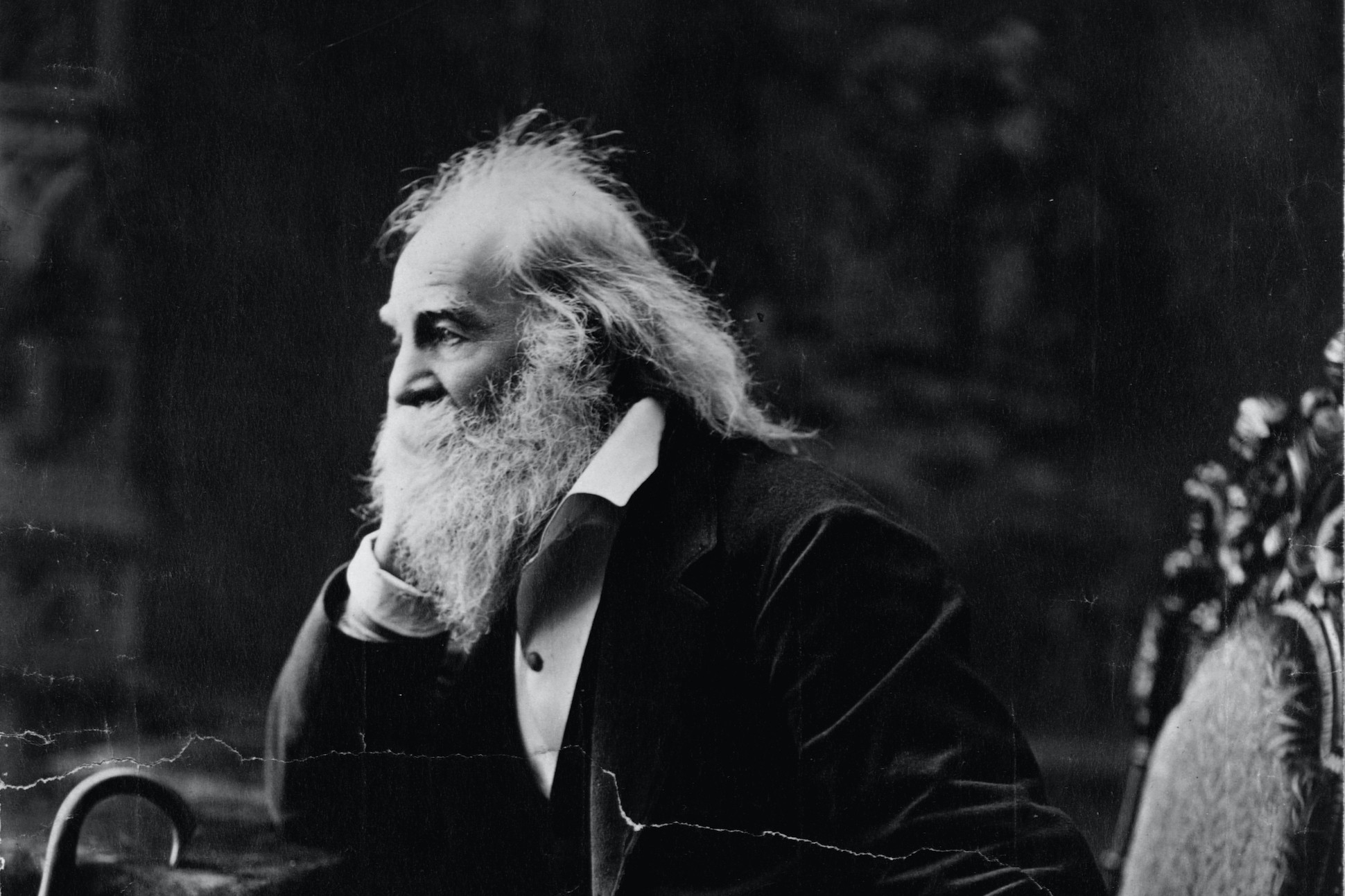“On the Beach at Night” by Walt Whitman is a haunting and powerful poem that reflects the beauty and mystery of the natural world. The speaker of the poem is a father walking along the beach with his child at night, and the vastness and power of the ocean strike him. He describes the waves crashing on the shore, the stars shining overhead, and the sense of awe that he feels in the presence of such natural wonders. Despite the sense of terror that the ocean can inspire, the speaker finds comfort in the thought that he and his child are a part of this vast and ancient universe.
Who is Walt Whitman?
Walt Whitman [31 May 1819-26 March 1892] is widely regarded as one of the most important and influential poets in American literature. His works are known for their innovative style, expansive themes, and celebration of individualism and democracy. Whitman’s poetry captures the spirit of American life in the 19th century, reflecting the country’s rapid expansion, political upheavals, and social transformations. He broke free from the conventional poetic forms of his time, using free verse and unconventional structures to express his ideas. Whitman’s works continue to inspire and challenge readers today with their profound insights into the human experience, their celebration of diversity and inclusiveness, and their unwavering belief in the power of the individual to shape history.
Whitman and his tryst with free verse
Walt Whitman once wrote, “To have great poets, there must be great audiences.” Indeed, Whitman’s use of free verse challenged traditional poetry and created a new audience for his work. While his contemporaries adhered to strict rules of rhyme and meter, Whitman’s free-flowing style allowed him to capture the essence of American life in a way that was both fresh and exciting. He once remarked, “I am as bad as the worst, but, thank God, I am as good as the best,” giving us a hint of the sense of humor and self-awareness in his own work. In breaking free from the constraints of traditional poetry, Whitman helped to redefine the art form and create a new generation of poets and audiences alike.
In the 19th century, rhyming verse was the norm in poetry, with poets following the traditional rhyming patterns and meter. However, Walt Whitman broke from this tradition with his innovative use of free verse. While traditional poets used rhyme and meter to create a regular rhythm and structure in their poetry, Whitman’s free verse followed a more organic and fluid structure, which is more reminiscent of everyday speech.
For example, in Henry Wadsworth Longfellow’s “The Tide Rises, The Tide Falls,” the poem’s structure is very regular and rhythmic, with a clear rhyme scheme throughout:
The tide rises, the tide falls,
The twilight darkens, the curlew calls;
Along the sea-sands damp and brown
The traveller hastens toward the town,
And the tide rises, the tide falls.
In contrast, Whitman’s “Song of Myself” follows no set rhyme scheme or meter and instead relies on the natural rhythms of the English language:
I celebrate myself, and sing myself,
And what I assume you shall assume,
For every atom belonging to me as good belongs to you.
This free-flowing style allowed Whitman to capture the spontaneity and diversity of American life in a way that was not possible with traditional poetic forms and paved the way for generations of poets to come.
Let’s talk about On the beach at night

Read the poem here.
Walt Whitman’s “On the Beach at Night” [1856] is a poem that explores the themes of mortality, the power of nature, and the cycle of life and death. The structure of the poem is free-flowing, with long lines and no rhyme or meter. This structure reflects the naturalistic feel of the poem and the speaker’s contemplative mood as he gazes out at the ocean. The use of vivid imagery, metaphor, and repetition also contribute to the poem’s overall effect.
The theme of mortality is also explored in the poem, with the speaker reflecting on the transience of life and the inevitability of death. The line “something there is more immortal even than the stars” suggests that there is something greater and more enduring than everything in the physical world. The poem further goes on to suggest that the natural world is beautiful and awe-inspiring but simultaneously dangerous and unpredictable. The clouds are described as “ravening clouds, the burial clouds,” which help create a sense of foreboding and sadness.
The emotional impact of the poem is most evident in the second stanza, where the child weeps silently, while watching the clouds. The father tries to comfort her, telling her that the stars will emerge again and that the clouds will not be victorious. This scene is poignant and touching as the father tries to console his child in the face of the unknown and the inevitable.
One of the most significant stanzas in the poem is the last one, which reads:
Something there is more immortal even than the stars,
(Many the burials, many the days and nights, passing away,)
Something that shall endure longer even than lustrous Jupiter
Longer than sun or any revolving satellite,
Or the radiant sisters the Pleiades.
This stanza suggests that there is something more enduring than anything in the physical world, whether it be stars, planets, or even the natural world. The poem encourages us to contemplate the cycle of life and death and appreciate the beauty and power of nature.
In conclusion, “On the Beach at Night” is a poignant and meditative poem that explores the mysteries of mortality, the power of nature, and the cycle of life and death. The use of vivid imagery, metaphor, and repetition creates a sense of awe and wonder as well as a feeling of connectedness with the universe. The poem encourages us to contemplate the transience of life and to appreciate the beauty and power of the natural world.
The historical significance of the poem “On the Beach at Night”
“On the Beach at Night” was written by Walt Whitman during the mid-1850s, a period of great social and political upheaval in the United States, a few years before the start of the Civil War (1861 – 1865), and the poem reflects his concerns about mortality and the fragility of life.
In addition to the Civil War, the mid-1850s was also a time of great change in American culture. The country was rapidly industrializing, and many people were moving from rural areas to cities in search of work. This period also saw the rise of new cultural movements, such as Transcendentalism and the Hudson River School of Art. Whitman was part of this cultural shift, and his poetry reflected his desire to capture the essence of American life and the American landscape.
In “On the Beach at Night,” Whitman uses vivid imagery to create a sense of the power and majesty of nature. The poem is set on a beach at night, and the speaker and his child watch as the stars emerge in the sky. However, the beauty of the scene is overshadowed by the presence of “ravening clouds, the burial clouds, in black masses spreading.” These clouds represent the forces of death and destruction that are ever-present in the world.
Also, Read – The Best Works of Enid Blyton and Why You Should Read Them
The poem also reflects Whitman’s belief in the cyclical nature of life and death. He writes that “the great stars and the little ones shall shine out again, they endure,” suggesting that although individual lives may be fleeting, the cycle of life and death continues unabated. This idea was particularly resonant during the Civil War when so many lives were lost in battle.
Overall, “On the Beach at Night” is a powerful reflection on the human condition, written during a time of great social and political upheaval. Whitman’s use of vivid imagery and his exploration of themes such as mortality, the cycle of life and death, and the power of nature make this poem a timeless meditation on the human experience.
Relevance of “On the Beach at Night” poem today
Walt Whitman’s “On the Beach at Night” remains a relevant poem today, over 150 years after it was written. The poem speaks to contemporary issues and themes, including environmentalism, the search for meaning in a complex world, and the enduring human struggle to find hope in the face of mortality.
One reason why the poem remains relevant today is its focus on the power and beauty of nature. Whitman was a passionate advocate for environmentalism, and his love for the natural world is evident in many of his poems, including “On the Beach at Night.” The poem’s vivid descriptions of the stars and the sea, and its celebration of the eternal cycles of life and death, continue to inspire readers to appreciate and protect the natural world.
Additionally, the poem’s emphasis on the search for meaning in a complex world speaks to a contemporary desire for understanding and connection. In today’s society, many people struggle with feelings of isolation, and the poem offers a sense of solace and hope. The poem reminds us that, even in the face of mortality, there is something enduring and immortal within us all.
Furthermore, the poem’s impact on modern poetry and popular culture is undeniable. Whitman’s unconventional style, with its long lines and free verse, revolutionized American poetry and continues to influence contemporary poets today.
Finally, the poem’s significance in the broader canon of American literature cannot be overstated. Whitman’s groundbreaking work helped to establish American literature as a distinct and vibrant tradition, and his influence can be seen in the work of countless American writers who followed in his footsteps. “On the Beach at Night” remains one of his most powerful and enduring works, and its themes and imagery continue to resonate with readers today.
Summing up
Walt Whitman, an iconic poet in American literature, broke free from traditional forms of poetry and created a new style of free verse, allowing him to express his ideas more organically. His famous poem, “On the Beach at Night,” is a contemplative reflection on the beauty and power of the ocean, the cycle of life and death, and mortality. The child’s tears and the father’s attempt to console the child create a poignant scene that speaks to the unknown and inevitable nature of life. Whitman’s unconventional structures, vivid imagery, and profound insights into the human experience continue to inspire and challenge readers today. His poetry captures the spirit of American life, reflecting the country’s rapid expansion, political upheavals, and social transformations.
We urge readers to read “On the Beach at Night” and other poems by Whitman to appreciate the beauty and power of poetry, which can change one’s perspective and, ultimately, your life. After all, to quote Robert Frost’s idea of what it means to read poetry: “Poetry is when an emotion has found its thought and the thought has found words.”


